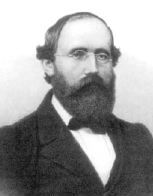

Bernhard Riemann's father acted as teacher to his children, and he taught Bernhard until he
was 10 years old, when he started studying at Hanover. Riemann seems to have been a good, but not outstanding, pupil who
worked hard at the classical subjects such as Hebrew and theology. He showed a particular interest in mathematics, and the director of the Gymnasium
allowed him to study mathematics texts from his own library. On one occasion, he lent Bernhard Legendre's book on the theory of numbers, and
Riemann read the 900 page book in 6 days.
In 1846, Riemann enrolled at the University of Göttingen. His father had encouraged him to study theology and so he entered the theology program, but soon switched to mathematics. There he was taught by Moritz Stern and Gauss. He moved to Berlin University in 1847 to study under Steiner, Jacobi, Dirichlet and Eisenstein.
Riemann's work always was based on intuitive reasoning which fell a little below the rigor required to make the conclusions watertight. However, the brilliant
ideas which his works contain are so much clearer because his work is not overly filled with lengthy computations. It was during his time at the University of
Berlin that Riemann worked out his general theory of complex variables that formed the basis of some of his most important work.
In 1849, he returned to Göttingen and he obtained a Ph.D, supervised by Gauss, in 1851.
Riemann's thesis studied the theory of complex variables and, in particular, what we now call Riemann surfaces. It introduced topological methods into complex function theory. The work builds on Cauchy's foundations of the theory of complex variables built up over many years. It is a strikingly original piece of work which examined geometric properties of analytic functions, conformal mappings and the connectivity of surfaces.
On Gauss's recommendation Riemann was appointed to a post in Göttingen and he worked for his Habilitation, the degree which would allow him to become
a lecturer. He spent 30 months working on his Habilitation dissertation, which was on the representability of functions by trigonometric series. He gave the
conditions of a function to have an integral, what we now call the condition of Riemann integrability.
To complete his Habilitation, Riemann had to give a lecture on geometry. Riemann's lecture in 1854, became a classic of mathematics. In the first part he posed the problem of how to define an n-dimensional space, and ended up giving a definition of what today we call a Riemannian space.
The second part of Riemann's lecture posed deep questions about the relationship of geometry to the world we live in. The lecture was too far ahead of its time to be appreciated by most scientists of that time. It was not fully understood until sixty years later.
Riemann was appointed as professor, and shortly thereafter another of his masterpieces was published. The paper Theory of abelian functions was
the result of work carried out over several years. This paper continued where his doctoral dissertation had left off, and developed further the idea of Riemann surfaces and their topological properties. He examined multi-valued functions as single valued over a special Riemann surface and solved general inversion problems which had been solved
for elliptic integrals by Abel and Jacobi.
In 1859, Dirichlet died and Riemann was appointed to the chair of mathematics at Göttingen. A few days later he was elected to the Berlin
Academy of Sciences. Newly elected members of the Berlin Academy of Sciences had to report on their most recent research, and Riemann sent a report on On the number of
primes less than a given magnitude, another of his great masterpieces which were to change the direction of mathematical research in a most significant
way. In it Riemann extended the zeta function to complex values, and gave the famous conjecture now known as the Riemann hypothesis, which remains today one of the most important of the unsolved problems of mathematics.